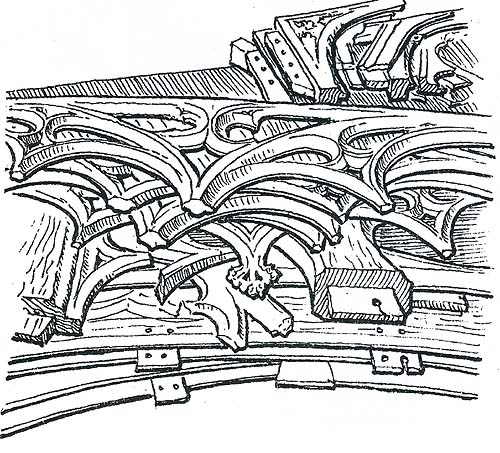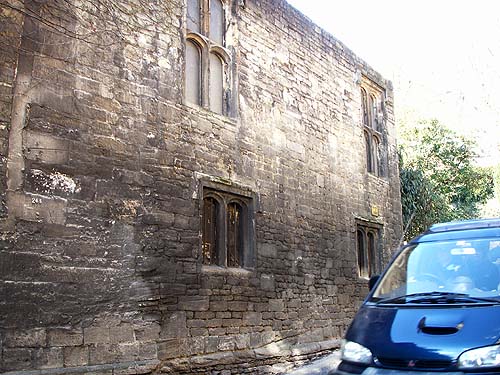When
members of the Preservation Trust went to see the roof of Rogers Manor in 1995,
it was a pile of timbers stored in Christie's warehouse. It was thought that the
roof might be incorporated in the Millennium plan for the Kingston Mills site,
but the Trust did not have the £40,000 to £60,000 at which it was
valued and, in the event, the plan failed to get Lottery funding. The trusses,
purlins and wind braces had been in storage since 1937, when The Priory' had been
demolished. The Priory' was a 19th century re-naming of the house known as Rogers
Manor or Methuens. The original manor house had been built in about 1450 by Thomas
Rogers, Serjeant-at-Law and clearly a man of considerable wealth. It remained
in the Rogers family until 1657, when it was sold to Paul Methuen. The Methuens
made many additions and alterations to the house. The Hall was 'modernised' with
classical doorways and plaster panelling, but the magnificent oak roof was left
untouched. In 1763 the Methuens sold to the Tugwells, another prominent family
of clothiers. In 1811 it was sold again, to John Saunders.
In 1850 Tomas Bush
Saunders leased the house to an Anglican religious order, the Sisters of the Most
Holy Trinity, for whom it was renamed The Priory'. They only stayed twelve years,
after which it reverted to the Saunders family until sold in 1920 to HJ. Bryons
and again in 1922 to Mr Alfred Frankel. He paid about £35,000 and spent
lavishly on the house and its 14 acres of grounds, but five years later he was
already trying to find a buyer. In 1930 it was advertised at £12,000 as
the "greatest bargain ever offered' but there were no takers. In April 1937
Messrs Harrods auctioned the property in 9 lots. The grounds and various small
buildings realised £2,955, but the highest bid for the house was £2,500.
It was decided to dismantle it and at a second auction in May 1937 doors, panelling,
mantelpieces, floor boards, staircases, a stone porch and much else was sold off
at ridiculously low prices. The roof of the Hall was bought by Mr Christopher,
the local chemist, but in 1995 Christies described it as "the property of
a lady". Subsequently it was in the hands of a firm of interior decorators.
Finally,
three years ago, it found a permanent home. Its new owner had a dining room added
to his Cotswold manor house, built to the same dimensions as the hall of Rogers
Manor. Over it the roof has been re-erected and appears just as it would have
done when put up by the medieval carpenters 550 years ago. Its elaborate cusping
betokens the wealth of the original builder; how fortunate that the new owner
had both the means and the vision to re-create it. He generously permitted members
of the Preservation Trust to see it in its new setting, and we are most grateful
to Annette Seekings for arranging the visit.
Gareth Slater
reprinted
from Issue no. 42, Guardian Angel (Autumn 2003)
The history of the Priory is
taken from the article by Margaret Dobson in Issue No 21 of the Guardian Angel
(Autumn 1996). See also Bill Anglis's article on the roof in Issue No 22 (Spring
1997).
|
ROGERS
MANOR which also became known as the manor of Bradford belonged to the Rogers
family. Thomas Rogers, Sergeant-at Law, lived at Bradford in the second half of
the 15th century. He apparently settled in the town after his first marriage,
to Cecily, daughter and coheir of William Besill. His son William Rogers succeeded
him and was himself succeeded by a son Anthony. During the reign of Henry VIII
Anthony Rogers, son of Anthony, held the 'manor' of Bradford. He died in 1583.
His daughter and heir Dorothy married John Hall (d. 1597) owner of Hall's manor
(see above). It would be natural to assume that the Rogers manor thus passed to
the Halls, but during the first half of the 17th century an estate described as
the manor of Bradford was held by members of the Rogers family. In 1623 a conveyance
of this manor was made by Edward Rogers and Katherine his wife and his sons Sir
Francis Rogers and George Rogers. Edward Rogers (of Cannington, Som.) was a descendant
of Serjeant Thomas Rogers by Thomas's second marriage, and he died in 1627, leaving
the manor to his heir Sir Francis. Sir Francis was succeeded in 1638 by his son
Hugh Rogers. Hugh Rogers and Dorothy his wife made a conveyance of the manor in
1653-38 In 1659 the manor of Bradford was apparently in possession of Henry Rogers
(possibly Henry, brother of Sir Francis Rogers), for in a chancery suit shortly
after it was alleged that about 26 November in that year Henry Rogers had sold
it to Daniel Witcherley for £3,000. The suit was brought by John Hurding,
who had allowed himself to be associated with Witcherley as trustee for the purchase
and who was now being sued for the residue of the purchase money, which Witcherley
had failed to pay.3'
There is no further mention of this manor. Probably it
passed like the house, later known as 'Methuens' to the Methuen family.
|




